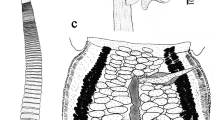Abstract
Linstowinema edmondsi (Echinonematinae) from Dasyurus hallucatus (Dasyuridae) is redescribed. It can be differentiated from all species of Linstowinema occurring in bandicoots (Peramelidae) in having the first row of cephalic hooks as long as or longer than the second row. L. gracile n. sp. is described from Phascogale tapoatafa and Dasycercus cristicauda, and can be distinguished from all previously described species of Linstowinema in not having a cuticular dilation of the oesophageal region of the body. L. rosamondae n. sp. from Dasykaluta rosamondae, described from females, also lacks the cuticular dilation of the oesophageal region and can be distinguished from L. gracile in having 18-19 rows of body hooks compared with 15. Other Linstowinema spp. for which there is presently insufficient material available for a full description include a single female occurring in Dasyurus viverrinus from Sydney, New South Wales, a single male occurring in Parantechinus bilarni from Kakadu National Park, Northern Territory and three damaged immature males occurring in Sminthopsis leucopus from Timbillica State Forest, New South Wales. Fourth stage larvae of Linstowinema have three rows of cephalic hooks but no body hooks, only spines. Fourth-stage larvae moulting to fifth-stage have body hooks however. This suggests that the genus Linstowinema, with body hooks, may have been derived from the echinomatine genus Inglechina which does not have body hooks.
Similar content being viewed by others
References
Baverstock, P.R., Flannery, T., Aplin, K., Birrell, J. & Kreig, M. (1990) Albumin immunlogic relationships of the bandicoots (Perameloidea: Marsupialia)-a preliminary report. In: Seebeck, J.H., Brown, P.R., Wallis, R.L. & Kemper, C.M. (Eds) Bandi-coots and bilbies. Chipping Norton: Surrey Beatty and Sons, pp. 13–18.
Chabaud, A.G. (1978) Keys to genera of the Superfamilies Cos-mocercoidea, Seuratoidea, Heterakoidea and Subuluroidea. In: Anderson, R.C., Chabaud, A.G. & Wilmott, S. (Eds). CIH keys to the nematode parasites of vertebrates. No.6.Farnham Royal: Commonwealth Agricultural Bureaux, pp. 31–33.
Chabaud, A.G., Seureau, C., Beveridge, I., Bain, O. & Durette-Desset, M.C. (1980) Sur les nématodes Echinonematinae. An-nales de Parasitologie Humaine et Comparée, 55, 427–443.
Gordon, G. & Hulbert, A.J. (1989) Peramelidae. In: Walton, D.W. & Richardson, B.J. (Eds) Fauna of Australia. Vol. 1B. Mammalia. Canberra: Australian Government Publishing Service, pp. 603–624.
Inglis, W.G. (1967) The relationships of the nematode superfamily Seuratoidea. Journal of Helminthology, 41, 115–136.
Inglis, W.G. & Mawson, P.M. (1967) Miscellanea nematodolog-ica. VI. Echinonema australis sp. nov. from Sminthopsis cras-sicaudata in South Australia. Journal of Natural History, 1, 173–175.
Kirsch, J.A.W., Lapointe, F.-J. & Springer, M.S. (1997) DNA hybridization studies of marsupials and their implications for metatherian classification. Australian Journal of Zoology, 45, 211–280.
Johnston, T.H. & Mawson, P.M. (1939) Sundry nematodes from eastern Australia. Transactions of the Royal Society of South Australia, 63, 204–209.
Linstow, O. von (1898a) Nemathelminthum von Herrn Richard Se-mon in Australien gesammelt. Denkschriften der Medicinisch-Naturwissenschaftlichen Gessellschaft Jena, 8, 469–472.
Linstow, O. von (1898b) Nemathelminthen von Herrn R. Semon in Australien gesammelt. Zoologisches Centralblatt Leipzig, 5, 672.
Morton, S.R., Dickman, C.R. & Fletcher, T.P. (1989) Dasyuridae. In: Walton, D.W. & Richardson, B.J. (Eds) Fauna of Aus-tralia. Vol. 1B. Mammalia. Canberra: Australian Government Publishing Service, pp. 560–582.
Quentin, J.-C. (1971) Sur les modalités d'évolution chez quelques lignées d' helminthes de rongeurs Muroidea. Cahiers O.R.S.T.O.M., Série Entomologie Médicale Parasitologie, 9, 103–176.
Smales, L.R. (1997) A revision of the Echinonematinae (Nema-toda: Seuratidae) from bandicoots (Marsupialia: Peramelidae). Transactions of the Royal Society of South Australia, 121, 1–27.
Yorke, W. & Maplestone, P.A. (1926) The nematode parasites of vertebrates. London: Churchill, 536 pp.
Author information
Authors and Affiliations
Rights and permissions
About this article
Cite this article
Smales, L. Linstowinema, Smales, 1997 (Nematoda: Seuratidae) from dasyurids (Marsupialia: Dasyuridae) from Australia. Syst Parasitol 43, 29–39 (1999). https://doi.org/10.1023/A:1006127915855
Issue Date:
DOI: https://doi.org/10.1023/A:1006127915855




